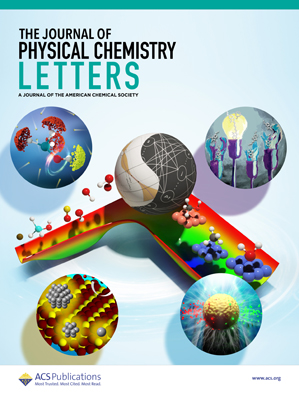螯合配体稳定的10族金属纳米团簇:手性和船椅结构转变
IF 4.6
2区 化学
Q2 CHEMISTRY, PHYSICAL
引用次数: 0
摘要
原子精度的金属纳米团簇弥合了金属原子和金属纳米粒子之间的差距,为金属纳米粒子的宏观特性与其微观结构的关联提供了理想的平台。与硬币金属纳米团簇的快速发展相比,由于10族金属纳米团簇的活性性质,人们对其的认识相对有限,这给合成带来了挑战。本研究成功合成了Ni3(SNS)3、Ni3(SNOS)3和Pd3(SNS)3三个10族金属纳米团簇,利用SNS钳形配体稳定镍和钯金属核。发现了源于表面SNS钳形配体不对称排列的纳米团簇的固有手性。观察到氧化诱导的不可逆转变,从船状Ni3(SNS)3到椅子状Ni3(SNOS)3,并揭示了船/椅子结构依赖的反应性。钳形配体稳定的Ni3和Pd3纳米团簇的结构特征和令人感兴趣的性质将激发对10族金属纳米团簇的进一步研究。本文章由计算机程序翻译,如有差异,请以英文原文为准。

Pincer-Ligand-Stabilized Group 10 Metal Nanoclusters: Chirality and Boat–Chair Structural Transformation
Atomically precise metal nanoclusters bridge the gap between metal atoms and metal nanoparticles, providing an ideal platform for correlating the macroscopic properties of metal nanoparticles to their microstructures. In comparison to the rapid development of coin metal nanoclusters, the knowledge on group 10 metal nanoclusters is relatively limited because of their active nature, resulting in the synthetic challenge. In this work, we successfully synthesize three group 10 metal nanoclusters, that is, Ni3(SNS)3, Ni3(SNOS)3, and Pd3(SNS)3, by using the SNS pincer ligands, which well-stabilize the nickel and palladium metal kernels. Intrinsic chirality of the nanoclusters that originated from the asymmetric arrangement of the surface SNS pincer ligands is discovered. Oxidation-induced irreversible transformation from boat-like Ni3(SNS)3 to chair-like Ni3(SNOS)3 is observed, and the boat/chair structure-dependent reactivity is revealed. The structural features and intriguing properties of Ni3 and Pd3 nanoclusters stabilized by the pincer ligand will inspire further research on group 10 metal nanoclusters.
求助全文
通过发布文献求助,成功后即可免费获取论文全文。
去求助
来源期刊

The Journal of Physical Chemistry Letters
CHEMISTRY, PHYSICAL-NANOSCIENCE & NANOTECHNOLOGY
CiteScore
9.60
自引率
7.00%
发文量
1519
审稿时长
1.6 months
期刊介绍:
The Journal of Physical Chemistry (JPC) Letters is devoted to reporting new and original experimental and theoretical basic research of interest to physical chemists, biophysical chemists, chemical physicists, physicists, material scientists, and engineers. An important criterion for acceptance is that the paper reports a significant scientific advance and/or physical insight such that rapid publication is essential. Two issues of JPC Letters are published each month.
 求助内容:
求助内容: 应助结果提醒方式:
应助结果提醒方式:


